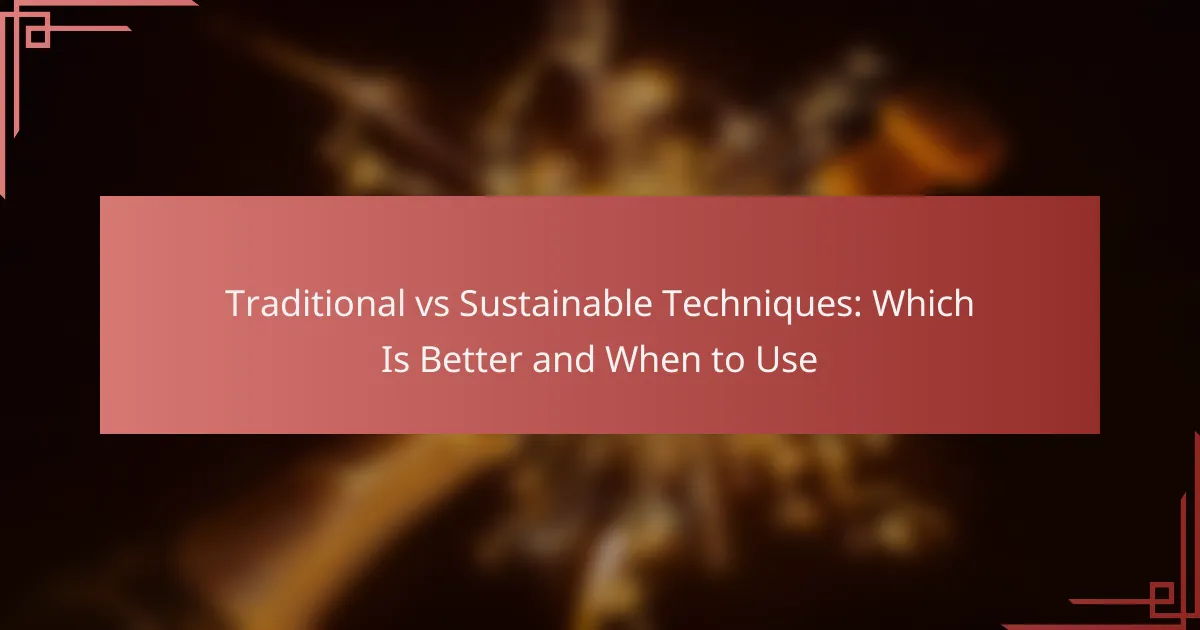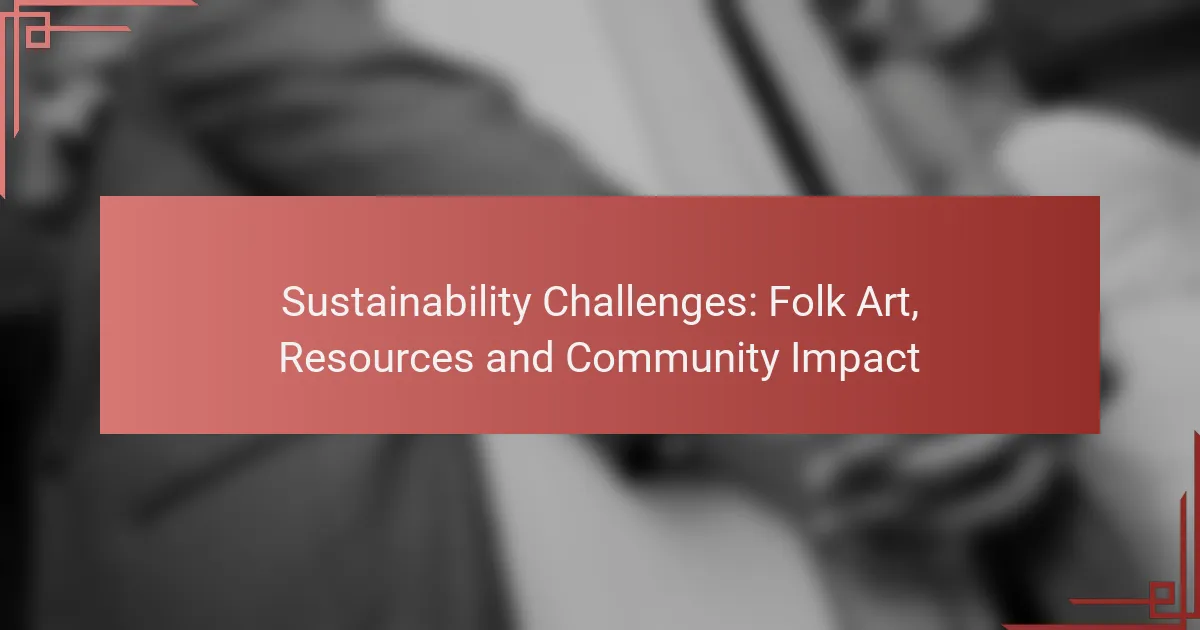In the ongoing debate between traditional and sustainable agricultural techniques, each approach offers unique advantages depending on the context of use. Traditional methods, honed over centuries, prioritize immediate results and high yields, while sustainable practices aim to enhance productivity with minimal environmental impact. Understanding when to apply each technique is crucial for optimizing agricultural outcomes and ensuring long-term viability.
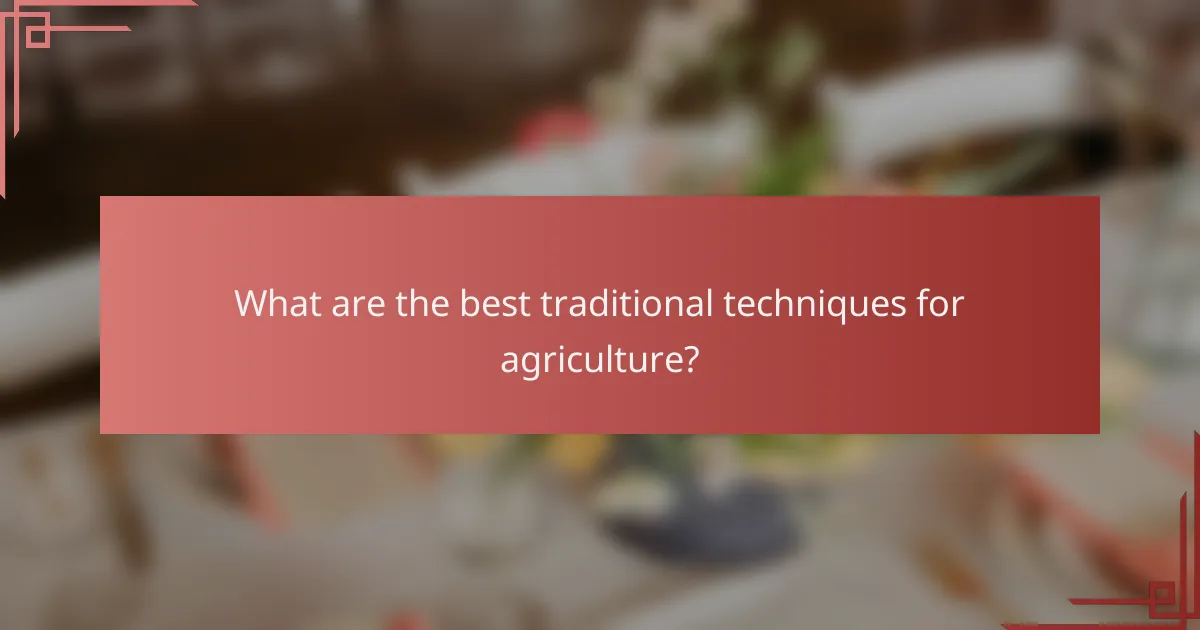
What are the best traditional techniques for agriculture?
Traditional agricultural techniques have been used for centuries and often focus on practices that enhance soil health and crop yield. Key methods include crop rotation, conventional tillage, and the use of organic fertilizers, each offering distinct benefits and considerations.
Crop rotation
Crop rotation involves alternating the types of crops grown in a particular area across seasons or years. This practice helps to prevent soil depletion, reduce pest and disease cycles, and improve soil structure. For example, rotating legumes with cereals can enhance nitrogen levels in the soil, benefiting subsequent crops.
Farmers should consider the specific needs of their soil and crops when planning rotations. A common approach is to follow a three- or four-year cycle, which can yield better long-term results than monoculture. Avoiding the same crop in consecutive years is crucial to maintaining soil health.
Conventional tillage
Conventional tillage is the process of mechanically turning over the soil to prepare it for planting. This method can effectively control weeds and incorporate organic matter, but it may also lead to soil erosion and degradation over time. Farmers often use this technique in regions where soil compaction is a concern.
To maximize benefits, it is important to time tillage appropriately, typically when soil moisture levels are optimal. However, excessive tillage can disrupt soil structure and lead to nutrient loss. Farmers should weigh the immediate benefits against potential long-term impacts on soil health.
Organic fertilizers
Organic fertilizers, such as compost, manure, and green manure, are derived from natural sources and improve soil fertility without synthetic chemicals. These fertilizers enhance microbial activity and improve soil structure, making them a sustainable choice for many farmers. They can be particularly beneficial in organic farming systems.
When using organic fertilizers, it is essential to apply them at the right time and in appropriate quantities. Generally, a well-balanced approach is recommended, with applications tailored to specific crop needs. Farmers should monitor soil nutrient levels to avoid over-application, which can lead to nutrient runoff and environmental issues.
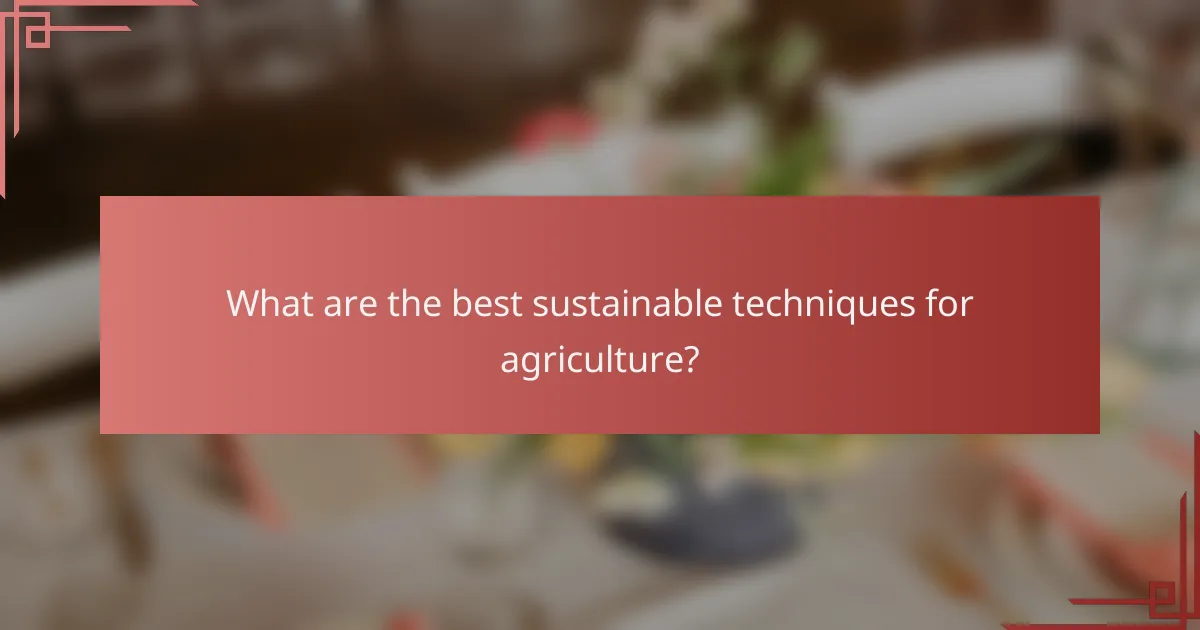
What are the best sustainable techniques for agriculture?
The best sustainable techniques for agriculture include methods that enhance productivity while minimizing environmental impact. These practices focus on maintaining soil health, conserving water, and promoting biodiversity.
Permaculture
Permaculture is a design philosophy that integrates land, resources, and people in a sustainable manner. It emphasizes working with natural ecosystems to create self-sufficient agricultural systems. Key principles include observing natural patterns, using renewable resources, and maximizing biodiversity.
For example, a permaculture garden might include a variety of plants that support each other, such as nitrogen-fixing legumes alongside fruit-bearing trees. This approach can reduce the need for chemical fertilizers and pesticides, leading to healthier soil and crops.
Agroforestry
Agroforestry combines agriculture and forestry practices to create more diverse and productive landscapes. By integrating trees with crops or livestock, farmers can enhance soil quality, improve water retention, and provide habitats for wildlife. This method can also offer additional income sources through timber or fruit production.
Farmers considering agroforestry should assess their land’s suitability for tree planting and choose species that complement their existing crops. For instance, planting shade trees can protect sensitive crops from extreme weather while improving overall farm resilience.
Cover cropping
Cover cropping involves planting specific crops during off-seasons to protect and enrich the soil. These crops, such as clover or rye, help prevent erosion, suppress weeds, and enhance soil fertility through organic matter addition. This technique is particularly useful in regions with heavy rainfall or erosion-prone soils.
Farmers should select cover crops based on their local climate and soil conditions. A common practice is to plant cover crops in the fall, allowing them to grow over winter and be tilled back into the soil in spring, thus boosting nutrient levels for the upcoming planting season.

When should traditional techniques be used?
Traditional techniques are best used in scenarios where immediate results are necessary or where high yields are prioritized. These methods often leverage established practices that have been refined over generations, making them reliable for certain agricultural contexts.
High-yield crops
Traditional techniques are particularly effective for cultivating high-yield crops, such as corn, wheat, and rice. These crops benefit from established methods that maximize production, often using familiar practices like crop rotation and selective breeding.
Farmers should consider the local climate and soil conditions when applying these traditional methods to ensure optimal growth. For instance, in regions with fertile soil, traditional techniques can significantly enhance yield, sometimes exceeding 10 tons per hectare.
Short-term projects
For short-term projects, traditional techniques can provide quick results, making them ideal for seasonal crops or emergency food production. These methods often require less initial investment and can be implemented rapidly, allowing for timely harvests.
Farmers should focus on crops with shorter growth cycles, such as beans or lettuce, which can be planted and harvested within a few months. Utilizing local knowledge and practices can further streamline the process, reducing risks associated with new methods.
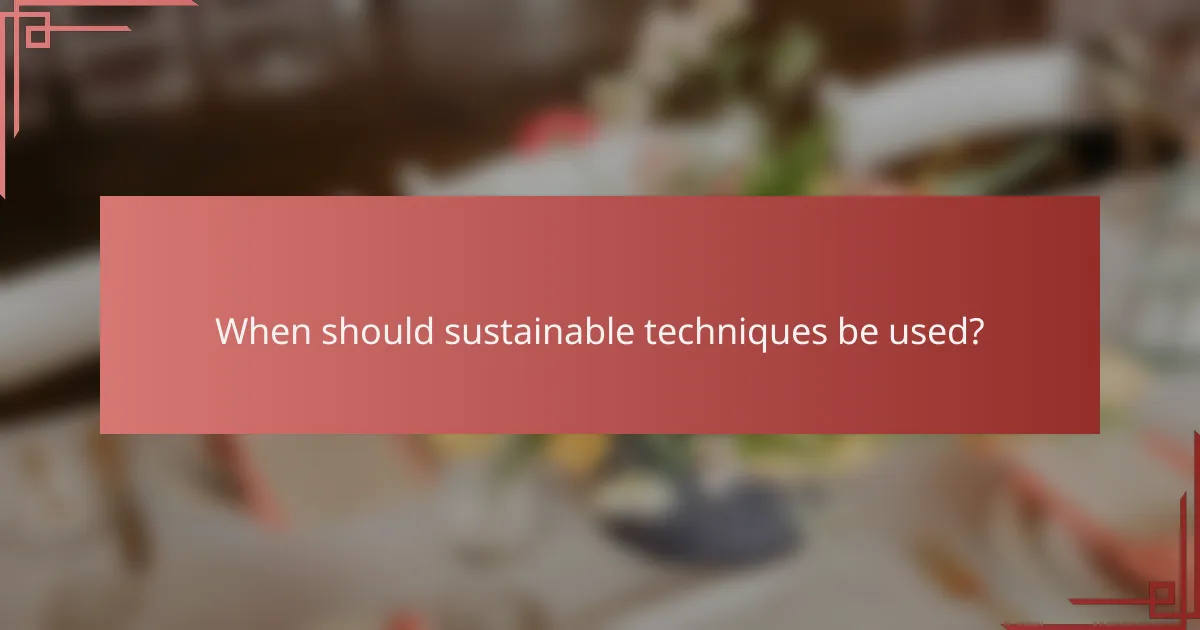
When should sustainable techniques be used?
Sustainable techniques should be used when the goal is to maintain long-term productivity while minimizing environmental impact. These methods are particularly beneficial in contexts where soil health and ecological balance are priorities.
Long-term soil health
Sustainable techniques promote practices that enhance soil structure and fertility over time. Techniques such as crop rotation, cover cropping, and reduced tillage help maintain organic matter and prevent soil erosion. By focusing on soil health, farmers can improve yields and reduce dependency on chemical fertilizers.
For instance, incorporating legumes into crop rotations can naturally fix nitrogen in the soil, reducing the need for synthetic inputs. Regularly assessing soil health through testing can guide decisions on amendments and practices that support sustainability.
Environmental conservation
Using sustainable techniques contributes to environmental conservation by reducing pollution and preserving biodiversity. Practices like integrated pest management and organic farming minimize chemical runoff into waterways, protecting aquatic ecosystems. Additionally, sustainable land management can enhance habitats for wildlife.
For example, maintaining buffer zones of native vegetation along waterways can filter pollutants and provide habitat. Implementing these techniques not only benefits the environment but can also enhance a farm’s resilience to climate change, making it a practical choice for long-term agricultural success.

What are the key differences between traditional and sustainable techniques?
Traditional techniques often prioritize short-term gains and established practices, while sustainable techniques focus on long-term environmental health and resource conservation. Understanding these differences can help in selecting the appropriate method for specific situations.
Resource usage
Traditional techniques typically rely on high resource consumption, including water, energy, and raw materials, which can lead to depletion and waste. In contrast, sustainable techniques emphasize efficient resource use, often incorporating renewable resources and minimizing waste through practices like recycling and upcycling.
For example, traditional agriculture may use chemical fertilizers and pesticides extensively, while sustainable farming practices focus on organic methods and crop rotation to maintain soil health. This shift can reduce overall resource input and promote a more balanced ecosystem.
Impact on biodiversity
Traditional techniques can negatively impact biodiversity by promoting monocultures and habitat destruction, which diminishes the variety of species in an ecosystem. Sustainable techniques, however, aim to protect and enhance biodiversity by encouraging diverse planting and preserving natural habitats.
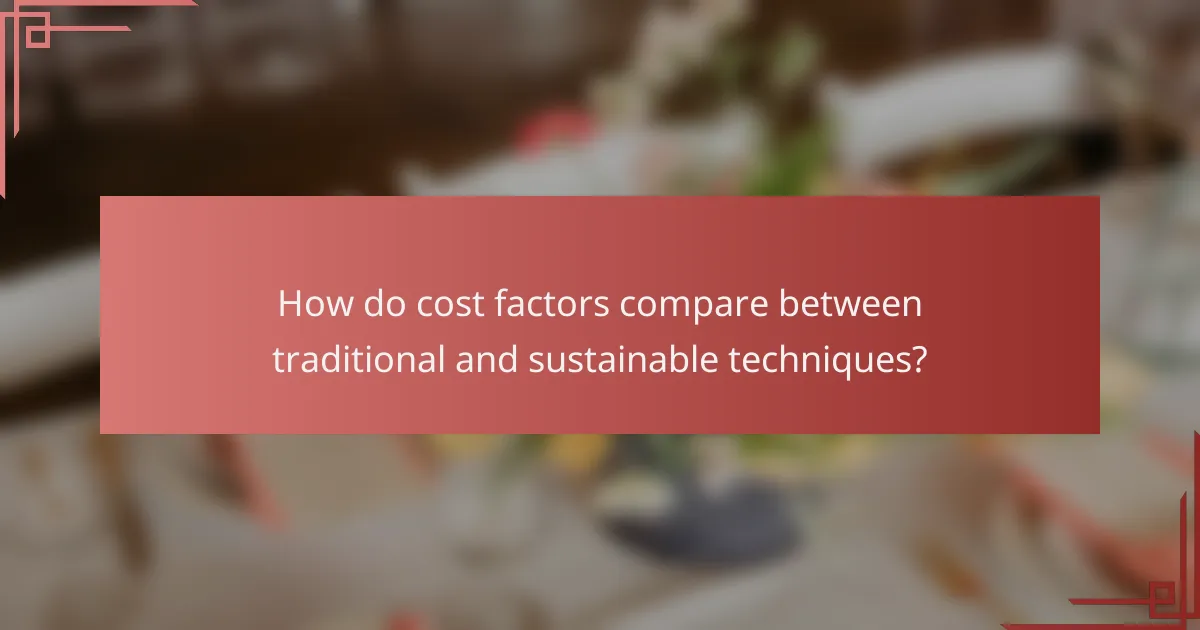
How do cost factors compare between traditional and sustainable techniques?
Cost factors for traditional and sustainable techniques vary significantly, influencing the choice based on project goals and budget constraints. Traditional methods often have lower upfront costs, while sustainable approaches may require higher initial investments but can lead to substantial long-term savings.
Initial investment
Traditional techniques typically involve lower initial investments, making them attractive for projects with tight budgets. For example, conventional building materials and methods are often less expensive than eco-friendly alternatives, which may include renewable resources or advanced technologies.
In contrast, sustainable techniques often require a higher upfront cost due to specialized materials and installation processes. However, these costs can be offset by incentives such as government grants or tax credits aimed at promoting environmentally friendly practices.
Long-term savings
While traditional techniques may save money initially, sustainable methods can lead to significant long-term savings through reduced energy consumption and lower maintenance costs. For instance, energy-efficient systems can decrease utility bills by a notable percentage over time.
Moreover, sustainable techniques often enhance property value and appeal, potentially leading to higher resale prices. Investing in green technologies can also protect against future regulatory costs associated with environmental compliance, making them a financially sound choice in the long run.
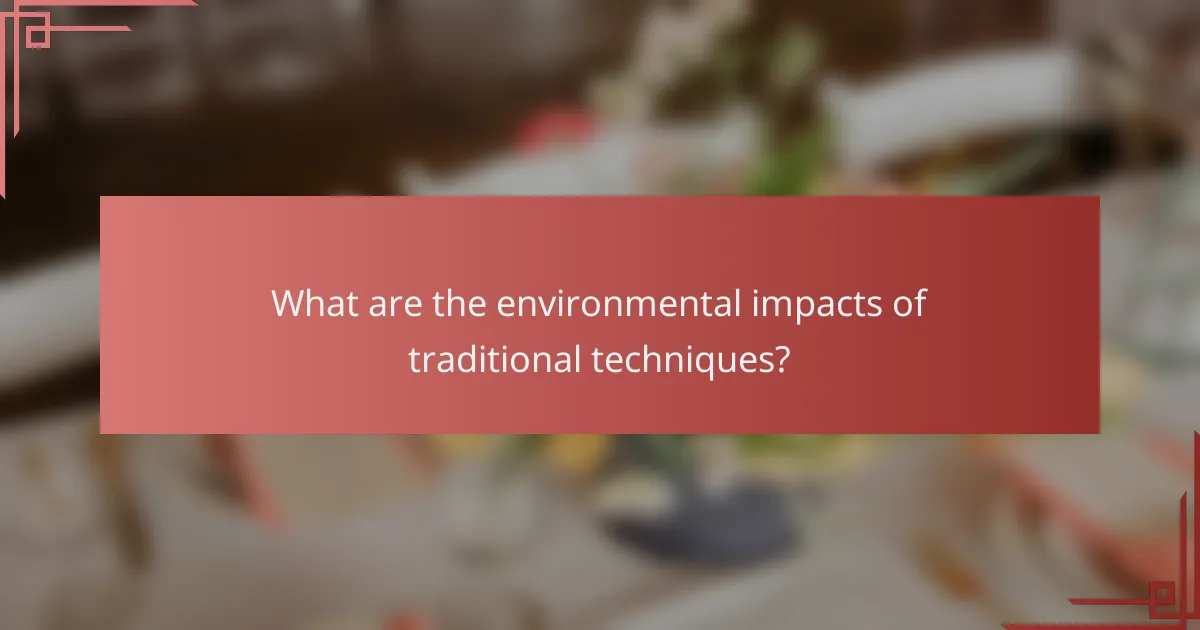
What are the environmental impacts of traditional techniques?
Traditional techniques often lead to significant environmental impacts, including soil degradation and water pollution. These methods, while historically effective, can compromise ecosystems and reduce the sustainability of agricultural practices.
Soil degradation
Soil degradation occurs when traditional farming practices, such as excessive tillage and monoculture, strip the land of nutrients and organic matter. This can result in reduced soil fertility and increased erosion, making it difficult for crops to thrive over time.
To mitigate soil degradation, farmers can adopt practices like crop rotation and cover cropping, which help maintain soil health. Avoiding heavy machinery during wet conditions can also prevent soil compaction, preserving its structure and fertility.
Water pollution
Water pollution from traditional techniques often arises from the runoff of fertilizers and pesticides into nearby water bodies. This runoff can lead to eutrophication, which depletes oxygen in the water and harms aquatic life.
To reduce water pollution, farmers should consider implementing buffer strips or vegetative barriers that filter runoff before it reaches water sources. Additionally, using integrated pest management (IPM) can minimize chemical use, further protecting local waterways.
